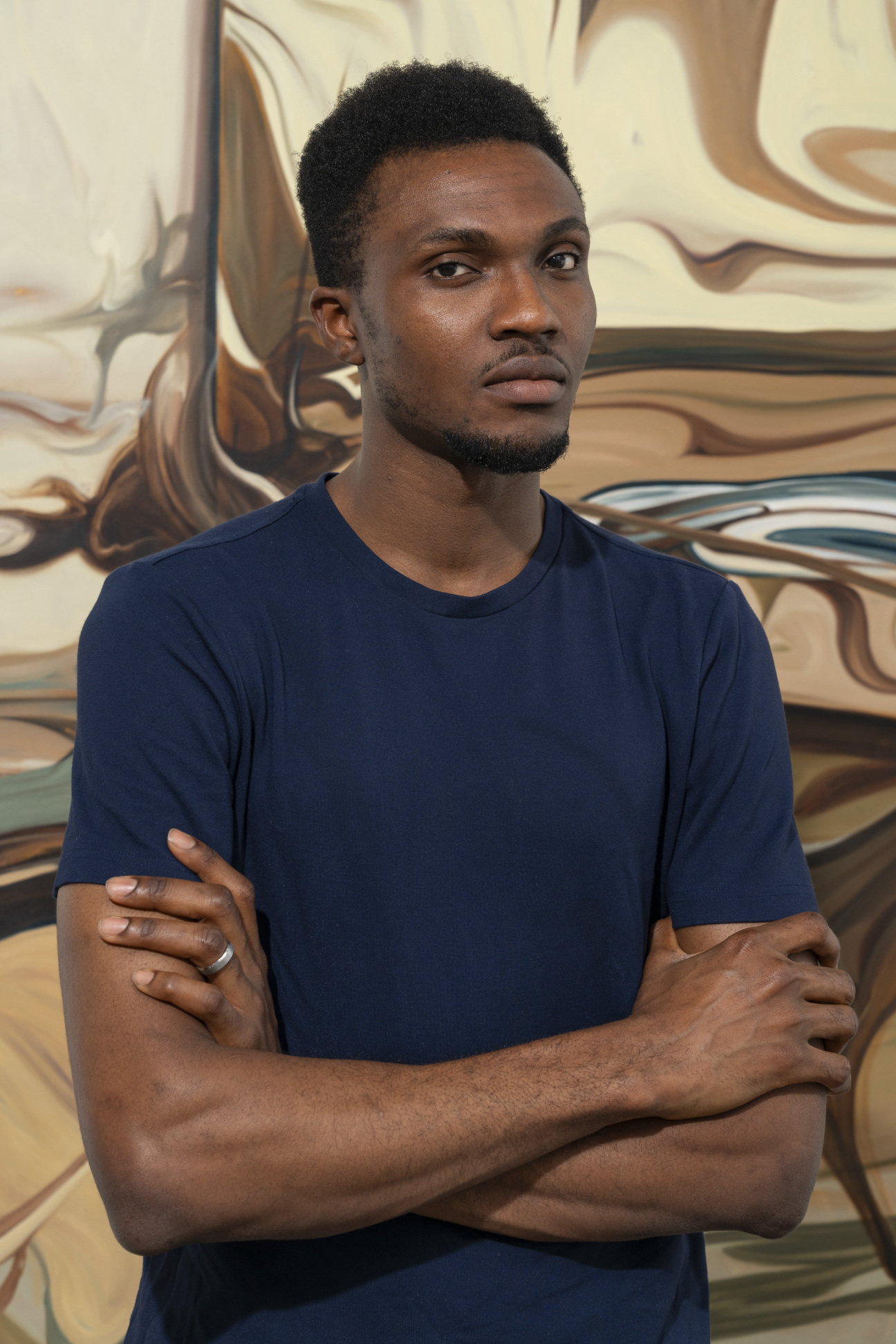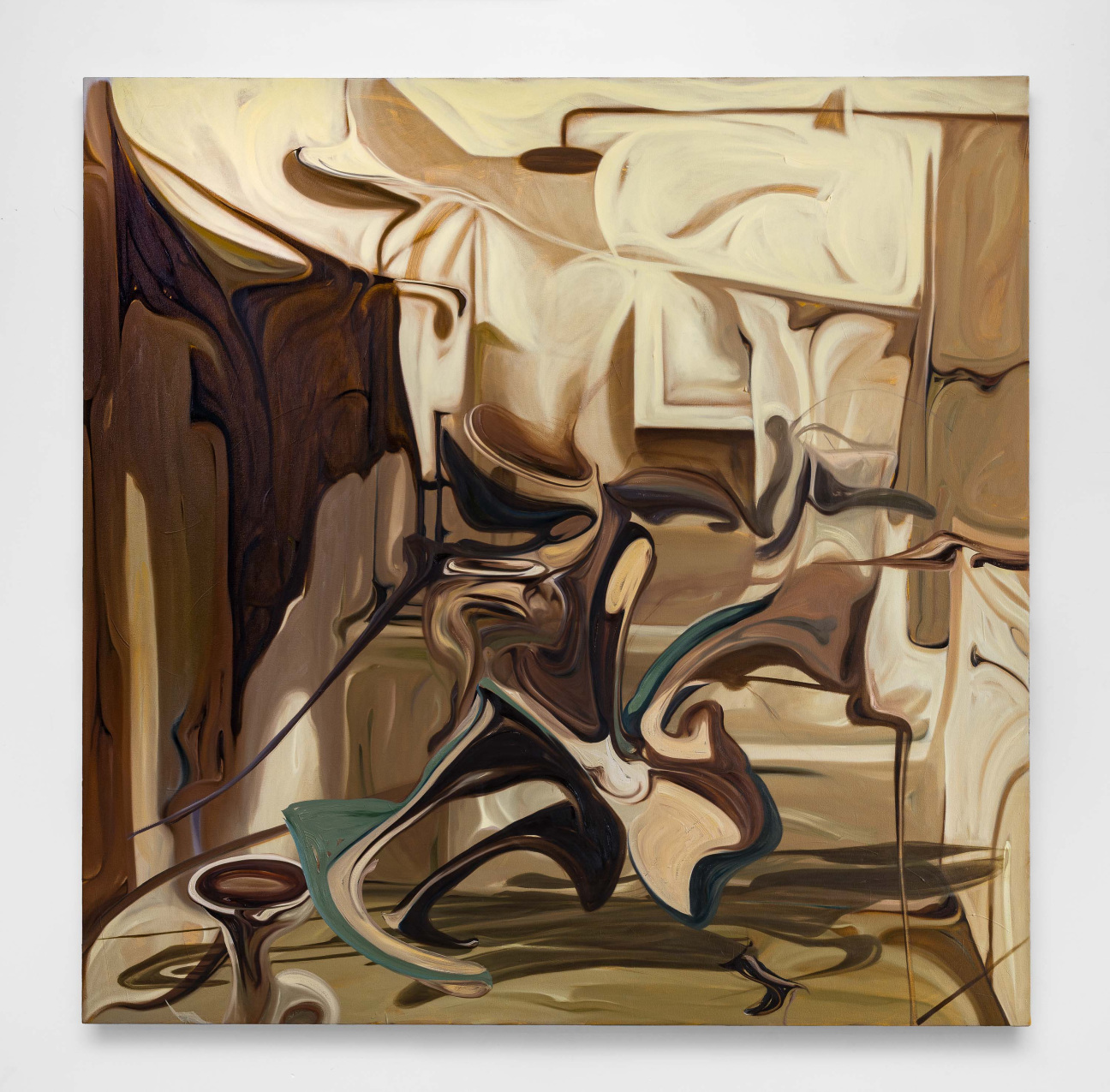
Luke Agada opens his first Los Angeles show at Roberts Projects on Sept. 28. It wasn't exactly a clear path for him to arrive here, growing up in Lagos and studing veterinary medicine before finding his way to painting. Taking inspiration everywhere from the color palette of his childhood to modernist masters like Picasso and Mondrian, Agada's abstract canvases are a contemporary surreal—at once familiar and not. Below, CULTURED sat down with the artist to talk about the question of home, certain colors becoming a safe haven, and the painters he turns time and again for inspiration.
CULTURED: You grew up in Lagos before moving to Chicago. How have these places influenced your work?
Luke Agada: It’s not so much about how the environment has impacted the work, but about how I have come to exist and adapt to this new space. The question of what home means or where we choose to call home has become part of my daily negotiations as I navigate the reality of immigration and the “alien status”; how much change comes with this shift in position within the globalized cultural space; who I choose to become here as one dwells within the intersectionality of citizenship, cultural background, and race.
I have not been home to Nigeria in two years. A lot has changed politically and socioeconomically in a very short time, and, quite frankly, the line between where I call home and where I make my home gets blurrier. As the novelist Chimamanda Ngozi Adichie aptly puts it, “One of the reasons I wrote Americanah is the question of what home means, and if you leave home whether you can go back. I think that for many people in my generation, home has come to mean often more than one place."

CULTURED: Can you talk about how your roots in Lagos shape your color palette and themes in this exhibition?
Agada: Every living person interacting with the world has a unique spectrum of colors that have become embedded in their senses as part of their visual experience. The human mind has been gifted to collect, record, and filter through the everyday comings and goings of their lived experience. Our unique visual perception has helped us to live life through colors. Every form that our minds interpret is made of up colors coming together in various tones through their interaction with light—that’s how I would define a “pictorial composition."
Hence, there are a range of colors that we each allude to as we travel through life. This spectrum of colors embedded in our memories have become a “safe haven” because it feels familiar. Some of it includes the color of skin or flesh—it’s everywhere. Some include the color of the geographical landscape or the solar intensity in the part of the world we live in. There is a range of colors that my mind has become accustomed to through my growing up in Nigeria.
I always say that the sun shines differently everywhere, or maybe it filters through the upper atmosphere differently, giving every city its own unique color palette. Many cities in Nigeria reflect the deep rich hues of the sun-burnt spectrum that I draw from. They evoke memories of home across different times for me. During my earlier days of developing as an artist, I was also mostly drawn to the color palette of the Old Masters and baroque painters, which I borrow from quite often.
CULTURED: Which painters are currently capturing your interest, and what draws you to their work?
Agada: I have looked to a lot of artists at different points in time, but currently I’m inspired by the work of abstract expressionist painters—like Willem de Kooning, Arshile Gorky, Roberto Matta—who were influenced by the surrealists and the modern masters of Europe like Matisse, Picasso, and Mondrian. Their work did not completely abandon the realm of the familiar to the point of radical abstraction. Their ability to play with biomorphic forms in an automatist approach, while maintaining strong pictorial values, gave me permission to explore more interesting territories in my work that stretched beyond ideological concepts and politics of representation.
However, I find myself returning to Gorky more. He has such a unique ability to freeze the most ephemeral moment in time yet retain strong compositions. I think I have lent myself the eyes of a surrealist but the hands of an abstract expressionist a bit. I am always moved by Picasso’s strong command of composition, both in his paintings and drawings.
Others include Edvard Munch, Francis Bacon, and Édouard Manet. There’s something about Manet’s color palette that feels so agreeable to the eyes.
CULTURED: You've mentioned being inspired by Homi K. Bhabha's concept of "third space." Bhabha’s theory focuses on an identity that is a complex hybrid, shaped by a multitude of factors including ancestry, power structures, and geography. The concept challenges binary oppositions in colonial discourse, suggesting a fluid understanding of cultural identity. How do you translate this theoretical idea into your visual art?
Agada: The Bhabhaian concept of identity as a process of negotiation and transformation is articulated through the adaptation of the forms within the “third space,” a psychological realm emerging from the intersection of memory, imagination, and observed reality within the paintings. I reflect on how this "third space," situated between the globalized constructs of culture, nationality, and other such categories, engenders ambiguous identities within these forms. This presents a poststructuralist challenge to fixed definitions of identity and the linguistic frameworks traditionally used to describe certain expressions.
CULTURED: How did you make the transition from being a self-taught artist in Lagos to studying at SAIC? Could you share more about that journey?
Agada: When I first began to make art, I was mostly interested in developing my technical ability in the use of materials. I was focused on the dexterity of great picture making, so I began to teach myself to paint in my spare time and picked up a few skills from street artists while I was in veterinary school. A point came when it became more serious for me, and I began to study everything I could find about being an artist: the art world, art history, and growing my studio practice. I was consuming everything that seemed to help me grow. But I soon realized my focus was not a guided one. I was searching for something, but I wasn’t sure what it was. When I encountered modern and contemporary art, everything changed. I realized I had been asking the wrong questions all along. The meaning of art changed for me from just a channel for ideological concepts to much more.
I was done with vet school and had a brief veterinary practice before I became a full-time artist. I had a few international shows before deciding to apply for an MFA program. I made that decision in order to grow out of the limitations in my understanding within my practice by getting the needed exposure and direct mentorship from some of the people I looked to who were outside of my locale.

CULTURED: You've described your work as visualizing the "anatomy of adaptation" for migratory bodies. What does this mean to you?
Agada: As a non-US citizen currently living in the United States, I have paid a bit of attention to the global discourse relating to the politics of border control and migration protocol. I have often reflected on the psychological impact of relocation itself, the mental stress, the integration versus preservation of cultures.
I look into how forms adapt into the space they are embedded in. The adaptive ability of an “alien” individual confers on them the ability to deal with the tension of the "third space." There is usually a feeling of otherness and tensions in adapting to a new culture by individuals within the "third space" of migration.
CULTURED: Your work has an unusual surface texture. What techniques do you use to create this?
Agada: The activity of painting itself can be quite mundane, but we often want to convince ourselves of the sublime or transcendental going on in the surface—like the painting is a miracle. That’s because we often prefer mystery to mundanity. In a way I like to have the painting challenge the logic of pictorial imagination without being utterly abstract. In order to do this, I have to make a lot of changes in the process of making a picture: pushing paint around the surface, shifting borders and form, cleaning off paint with rags, rubbing off semi-wet paint with a dry bristle brush, layering and exposing underpainting to create more tension. In this place, foreground becomes background and vice versa. It’s a story of acceptance and rejection. The tactile nature of paint as it interacts with the surface is interesting to me.
I have often thought about Hans Hofmann’s theory of painting that says, before being anything else, a painting is an arrangement of colors and forms on a two-dimensional surface. Added to this was his formulation of a principle he called "push and pull"—a tension between the flat surface of the canvas and the sense of depth, or third dimension, evoked by the elements of color and form that the painter places upon that surface. I try to create depth by not just following the perspectival rule, because in a pictorial or plastic sense, depth is not created by the arrangement of objects one after another towards a vanishing point, but by the creation of forces in the sense of push and pull.










 in your life?
in your life?

